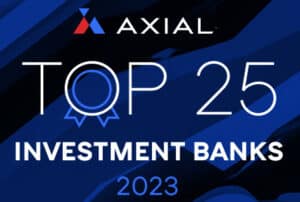
Selling a business comes with a lot of uncertainties. While a would-be seller can’t always control which parties are interested in buying, the seller does control the way the business is managed and scaled leading up to the sale—and the way they use their leverage in negotiations. FOCUS Partners George Shea and Manan Shah discuss the current selling climate, typical exit process, and the importance of a strong management team.
Q: Owners and executive management are constantly interested in what they need to know to get the business to a stage where it is attractive for sale. What does FOCUS look for?
George: Our specialization is high technology, from software to managed services, consulting, systems integration, and IT staffing. The needs in those spaces are quite different, so we look at each of those as a separate space with its own unique attributes and potential liabilities. We are looking for a motivated selling group of shareholders.
The vast majority of our sell-side assignments are entrepreneurially led, driven, and owned organizations that have not done a sale or major transaction before. This is a life-changing event for most of our clients. We need them to be motivated because, by and large, first-time sellers don’t realize the extent of the process or the time investment required to really affect a sizable transaction on their behalf.
Q: If you’ve not been through an exercise like this before, it must be a fairly emotional one. Having spent so many years building something, how do you actually know that the timing is right?
George: Being able to navigate the emotional pitfalls of a transaction—which include seller’s remorse, something that is invariably an ingredient in every deal—is important. Manan and I and the other partners as well as our IT group are all former CEOs of companies in the industries that we serve. That’s important, because we’ve all had the same emotional pitfalls that our clients are going to certainly experience
Manan: One thing the potential sellers ought to keep in mind is that when their business looks attractive to them, it looks attractive to the buyers as well. When business owners look at a very strong growth in the pipeline and the market conditions are right, they should start thinking about exit options. If you read some about some of the most successful exits, most of those entrepreneurs would say that they sold too soon, and that it was the reason behind their success.
Q: You mentioned market conditions—how much do entrepreneurs and people who are looking to sell their business need to think about timing?
Manan: Timing is a very important consideration in a sale process. During the last three years especially, we’ve seen probably one of the highest levels of M & A activity. Debt is fairly easily available for most of the acquirers, and the cost of capital is relatively low. In addition to that, it’s much easier to buy yourself into a particular market or customer base as opposed to organically growing into it. The buyers have acknowledged that, realized that, and therefore the M & A activity has been pretty strong. This is a good time for serious sellers to explore, especially if they have certain ingredients in place with regards to selling their business.
Current Selling Climate
Q: What industries are particularly good targets?
George: From the buyer’s perspective, what we’re seeing in the market place is a real premium on recurring revenue. That translates really to two business models that we currently serve: one is software as a service (SAS), and the second is managed services, or outsourcing.
A number of our clients are in that space, and a lot of clients that previously were focused almost entirely on consulting or systems integration are migrating up and transforming their business to a higher recurring revenue model. Buyers are rewarding that with higher evaluations.
Q: If I am a seller in a space that’s hot right now and I don’t sell, do your technology windows that close for the sale of those businesses?
George: Before we take on a client situation, we look at the competitive landscape and see if, indeed, the market has swallowed up everybody in it. One of the drivers that creates value is scarcity, and that window can pass where indeed everybody’s been swallowed up and the market is no longer viable.
Q: You’ve said your profile client is doing about $10 million a year in revenue and more, but what if I’m $6 million, but I’m in an area that seems of interest. Tell us what that process actually looks like.
George: The whole objective here is not to sell a company prematurely at a low valuation just because they want to sell. Our objective, always, is to get the best possible valuation for our clients. We do that by bringing in multiple offers and using competitive leverage to scale up the offers one against the other to get premium value.
If we’re dealing with a company with fairly minimal revenues, it’s going to shrink the buyer community pretty dramatically, because most folks aren’t interested in buying smaller companies. Our best advice, even in that market, is to scale the company a bit. Once they reach a little higher level, we’ll be glad to represent them.
Manan: On the other hand, if the company’s in a hot space and they have a technology that addresses needs that big buyers are looking for, we would certainly consider that pretty seriously. Make sure that if they are in a hot segment of the market that it might be a benefit to find a buyer early.
The Process
Q: Let’s say I’ve hired FOCUS. We sign an engagement letter, and what happens next?
George: Before we even take on an engagement formally, we do preliminary work on valuation. That includes a lot of analysis that our research department doe, and that we do individually and collectively: looking at comparable transactions, looking at the public market, and looking also at a very important, and often overlooked piece, which is called the outlier market. By that, I mean people who are in complementary spaces to our client, but could be logical buyers.
We see this as a potential corollary, and a good way for them to add to a substantial business they already have. Once we have signed an engagement letter, our next step is two-fold. We have a kick-off meeting with one of our senior research staff, which takes about half a day, perhaps more
In that, the objective is to come out with two specific deliverables for all of our clients. One is a confidential information memorandum, or marketing document, which highlights our client’s strengths and is sent to buyers that we feel are strong, interested, and have signed a non-disclosure agreement.
The second is a target list. That will include, again, a range of players from strategic buyers to financial buyers, and international buyers. The last one is most important for our purposes, because about 25 to 30 percent of our business includes international buyers, particularly from the far East and Europe. That list is a compendium of Manan and my contacts, the firm’s contacts, plus third-party research groups to find buyers that otherwise would be well below the radar in a particular transaction.
Q: When you do get engaged, have you already determined the business actually is ready to sell? We talked a bit about making sure there’s a succession plan, where it’s not so dependent on the owners, there are recurring revenues. What is your diligence process?
Manan: There is a certain value for every business. If you start building some of these elements—what we call key value drivers—into the business. It may take some time, but your value will increase. Sometimes the business owners may want to retire for health reasons, or what have you.
Then, it’s a matter of them acknowledging what value they are able to get from the market for the business in its current condition. Meanwhile, some business owners have more time left with their businesses, and we can coach them, help them understand what sort of things they should start putting in place, that would happen over three months, six months, a year or two, or sometimes even longer. That’s an ongoing process, and at some point we initiate that sale transaction.
George: One of the things we delve into pretty deeply, with respect to the clients, is their ability of them to come forth on a timely basis with due diligence requests. That means they must have a pretty sound infrastructure internally, particularly with financial due diligence requests and the ability to turn around and answer buyer’s questions in a prompt and timely manner.
Q: Going back to the process, when you send out the confidential memorandum and you contact your contacts, what happens after that?
George: One of the things that’s interesting about our firm is that we’re partner owned, partner drive, and basically once we get an engagement Manan and I do all the work ourselves. We send out the letters to perspective buyers. We ordinarily get a strong response from the buyer community.
In that context, once we have people interested, and we invariably do, then we send out basically a note requesting indications of interest after the confidential information memorandum has been reviewed by the buyer. That’s the next step, prior, really to a formal letter of intent.
Once they send an indication of interest then we’re able to ascertain exactly what their valuation parameters are, and whether those parameters are interesting to our client and ourselves. If that’s the case, then we’ll have client meetings, then basically go to a process which will result in a formal LOIs [letters of intent] from perspective buyers and a selection group put together, then finalizing the right buyer for us.
Negotiation
Q: Talk about the negotiation process for a letter of intent, because if you’re only going through this for the first time ever it might be a little difficult as a seller to know what you should be doing. What does that look like?
Manan: It’s a two-step process. The first step is that once we send the confidential information memorandum out, a number of times we have a fairly good number of potential interested parties that are requesting these information memorandums. In order to try and make sure that we spend our clients time wise, we request preliminary indication of interest from each of the buyers that receive the information memorandum.
Once we collect those, we try to narrow it down to eight to ten groups, and we focus on our client’s efforts and invite them into management presentations. Once those management presentations are complete, we make a formal request for a non-binding letter of intent, which would be a very specific offer to acquire our client’s business.
Once we receive those we will then see where the best fit is for our client, and where the best value is, and basically create a competition amongst interested parties in order to try and maximize value for our client. Again, most of our clients, most of these companies are privately owned, so their shares really don’t have a market. We create that market by generating competitive interests from interested buyers.
Q: How open are you in the competitive bidding process when you have multiple people that are bidding to buy a business?
George: Once we get down to the final buyers, then it’s time to really start the negotiation and tell them what they need to do to get the business—not just cash up front, but what about the overall structure, management compensation, the entire panoply of transaction points is critical.
“Get those down and get those solidified if you want the deal.” We’ll tell people very specifically what they need to do to get the deal, particularly in cases where the client is leaning toward a particular buyer.
Different Types of Buyers
Q: What are buyers actually looking for and what are the different sorts of buyers that are out there? What is the difference between financial buyers and strategic buyers?
Manan: Strategic buyers are companies that are either directly in the business that our clients would be in or somewhere adjacent to that, but they really have an operating business. The financial buyers, on the other hand, are folks like private equity groups—investors. They acquire the companies, with the intention of building them up for the next five to eight years, then eventually having an exit and general returns for their investors or for the fund.
There are a whole host of other financial buyers these days in the market. For example, we are seeing lots and lots of situations where the private investors have come together to back a management team, or the CEO candidate, and basically their desire will be to acquire and install that candidate as a CEO of the business and invest in a company that way.
In addition to the typical private equity funds, we are seeing a number of search funds with this model where they would have the discretion of underwriting that investment.
Q: Something we see a lot is a seller who already has a relationship in place, and has been approached, usually in the strategic context by a buyer. They think, since they weren’t even considering selling at that point, they think this probably is their highest and best offer because they’ve never heard from anybody else. They’re scared to actually engage any investment bankers at that point, one, because they don’t want to pay a fee. Two, because they don’t think that they can really do any better than this offer. What are your thoughts on someone in that situation?
George: Our strong belief is that the way to get premium value for any company is to have multiple offers where we can leverage one offer against the other to get the best possible value for our clients. If you’re talking about one strategic buyer that’s made an offer, which may be a decent offer, you’re at risk. Essentially, if you’ve got no backup and that horse goes off the trail, so do you.
Importance of the Management Team
Q: What happens to a business owner who is actually working in the business? They often say they don’t want to stay, and would rather go at closing. Is there any chance of that? What do you see?
George: It really depends on circumstances. A lot of private equity groups are inclined to bring in their own CEO or their own management team. From a strategic buyer’s perspective, very often they’ll want to bring in their own team. Seller retention is not as critical as it would be in the ordinary private equity majority recapitalization transaction.
Manan: The most important point in this regard is to be very open with the buyers about the desired objectives of the sellers. We’ve done transactions where the sellers have been able to retire day one, as long as that was communicated up-front in the process. The buyers evaluated accordingly. That may not be acceptable to certain types of buyers, but they would just not proceed further with the process.
Most of the buyers, by and large, desire some level of continuity from the selling owners, just to make sure that there is no disruption with the business. Buyers are more agreeable to a one- or two-year transition plan for business owners to move on, but we’ve done transactions both ways.
George: One of the things that’s really critical in that context is the relationship between the founder/CEO and the customers. The founder needs to have brought on a sales group and the customer relationship management must be ingrained in the sales organization and not contained in the CEO. It’s much more marketable that way because it takes out a risk factor.
Q: What do you see with regard to that non-owner team—perhaps they have options or some small increment of ownership. Does that management team often stay on the other side of the transaction?
Manan: The management team is critical for buyers to make sure that that the continuity is there. Generally speaking, the buyers are very open about their assessment of the management team, and if there is a particular member that is not necessary post transaction, they would generally be open about that.
Most of the times those positions end up being back office functions as opposed to front office functions. Buyers typically don’t want to see any disruptions with the customer relationship or people that are engaging with the end client relationship. Most of the buyers do prefer having continuity with the management.
Q: What do you usually recommend with regard to the owner, in telling a management team that they think it’s time to put the business up?
Manan: It’s always a big challenge. Most of the owners would not like to share this until a transaction is imminent. We always advise our clients that the sooner they’re in a position to tell their key management team, the better off they are. If they can take them into confidence early enough to support the process, everybody will be better off.
But often, we have to manage it towards the very end of the process: once the transaction is imminent, all the due diligence has been done, all the purchase agreements have been negotiated. A lot of clients do prefer to share the news at that point with their management.
George: Much of that depends on the culture and the equity distribution at a particular company. If you’ve got a company that’s extremely open, where everybody is basically a stock holder—or has the potential to be a stock holder through options, warrants, et cetera—then often you’ll see the management sharing with the employees. “This has been our goal from the beginning, to sell. This is what we’ve all been talking about for a long time.”













